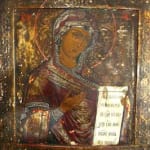The Mother of God, 18th Century CE - 19th Century CE
Tempera on Wood
12.5
PF.5984
Further images
Russians inherited the tradition of icon painting from Byzantium, where it began as an offshoot of the mosaic and fresco tradition. During the 8th and 9th centuries, the iconoclastic controversy...
Russians inherited the tradition of icon painting from Byzantium, where it began as an offshoot of the mosaic and fresco tradition. During the 8th and 9th centuries, the iconoclastic controversy in the Orthodox Church called into question whether religious images were a legitimate practice or sacrilegious idolatry. Although the use of images was in the end permitted, a thorough distinction between profane art intended to depict reality and sacred art designed for spiritual contemplation was established. That difference is one of the reasons that the artistic style of icons can seem so invariant. Certain kinds of balance and harmony became established as reflections of divinity, and as such they invited careful reproduction and subtle refinement rather than striking novelty. Although this philosophy resulted in a comparatively slow evolution of style, icon painting evolved considerably over the centuries. Unlike the pictorial traditions of the west that aspire towards increased realism and naturalism, the essence of Russian icon painting is not about the representation of physical space or appearance. Icons are images intended to aid in contemplative prayer, and in that sense, are more concerned with conveying meditative harmony than with laying out a realistic scene. They were not painted to please the eye of the mind, but to inspire reflection and self-examination.
Depictions of the Mother of God alone are quite rare, she if most often represented along with the Christ child. However, in this powerful icon, the Virgin is shown alone holding a text that she points to. This unusual posture is related to a famous Greek Orthodox icon from the twelfth or thirteenth century called the Paraclesis. The influence of this celebrated painting is evident both in the slight tilt of Mary’s head and in the gesture of her right hand. When the two works are compared, one realizes how firmly rooted in tradition icon painters were.
Depictions of the Mother of God alone are quite rare, she if most often represented along with the Christ child. However, in this powerful icon, the Virgin is shown alone holding a text that she points to. This unusual posture is related to a famous Greek Orthodox icon from the twelfth or thirteenth century called the Paraclesis. The influence of this celebrated painting is evident both in the slight tilt of Mary’s head and in the gesture of her right hand. When the two works are compared, one realizes how firmly rooted in tradition icon painters were.





